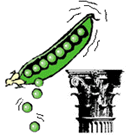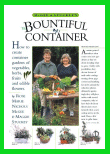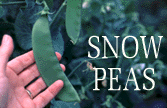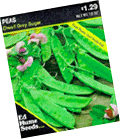
Dilly Snap Peas
Fun facts about snap peas and a
pickle recipe to die for
By Marion Owen, Fearless Weeder
for PlanTea, Inc. and
Co-author of Chicken Soup for the Gardener's Soul
FEATURE ARTICLE:

Tom Hanks' "Power of Four" solution
More good stuff:
Who is Marion Owen?
FAQs about PlanTea
Search Marion's articles, tips and recipes
Why grow organic?
News and press releases
Read love letters
How to link to this site
Need a speaker?
How to contact Marion
Visiting Alaska?
Come to Kodiak Island!
Go to home page

Marion's UpBeet Gardener
Newsletter has been
replaced by Marion's blog
which you can find at:
www.marionowen.wordpress.com
Did you know that peas are one of the world's oldest crops? It's true. Wild peas were foraged centuries before they were domesticated as the trellis champions we know today. Yes, the matriarch of vegetables gleefully lives on, delighting children in the garden and rounding out (sorry) classic recipes. (Remember tuna casseroles?) Here's a sneak pea-view, including history highlights, short takes on podded peas, inspirations--and as promised, a pickle recipe using edible snap peas. It's to die for.
For centuries, peas enjoyed a popularity that rivaled today's sliced bread. During the Roman Empire however, peas fell off the culinary pedestal. Suddenly they were poisonous and had to be dried before they could be consumed.

Considered poisonous during the Roman empire,
peas fall off the culinary pedestal.
War and peas
Then
came the Thirty Years War (1618-1648) which developed into a nasty  struggle
for the balance of power in Europe. In France, Louis the XIV was busy
with foreign wars and financial woes, yet he did much to improve French
culture and the arts, symbolized by the palace and gardens at Versailles.
struggle
for the balance of power in Europe. In France, Louis the XIV was busy
with foreign wars and financial woes, yet he did much to improve French
culture and the arts, symbolized by the palace and gardens at Versailles.
One day, a French gardener, who was probably bored with the same old boiled
porridge, looked at the wild pea growing along the road and thought, "Perhaps
I can improve this petit vegetable." Soon, his field trials produced a
green pea hybrid known as petits pois [pronounced PET-eet PWAH]. Fresh
peas became all the rage at the king's court and its green roundness was
soon enjoyed far and wide.
Peas don't demand much. Just give them halfway decent soil and vine support. And, if you're long on desire but short on space, peas can be grown in containers, along walls, trained up corn and sunflower stalks, and even in hanging baskets. Speaking of containers, here's a book that's been hailed as "The bible for small-space gardeners who want to grow what they eat."

The Bountiful Container, by McGee & Stuckey
(Workman Publishing)
There are wrinkled peas, smooth types, yellow peas, black-eyed peas, crowder peas, cream peas, bushing and climbing varieties, and the types that cool climate gardeners love like a favorite wool sweater: Snow peas and snap peas.

FOR 1/2 CUP OF COOKED SNAP PEAS:
Calories: 34
Dietary Fiber: 1.4 grams
Protein: 2.6 grams
Carbohydrates: 5.6 grams
Vitamin C: 38.3 mg
Iron: 1.6 mg
Potassium: 192 mg
Magnesium: 21 mg
Peas on earth
Kissing cousins to the garden pea, snow and snap peas thrive in cooler soils and produce oodles of eat-the-whole-thing, edible pods. Snow peas produce flat pods that you can munch either raw (try them in a sandwich) or cooked in hundreds of dishes--even grilled on the barbecue. Snap peas are a little more versatile--eaten as young flat pods, or, if you let them blimp out a few more weeks, you can eat them whole or as shelled peas. The trick is to pick snow and snap peas every few days to enjoy them at their best. If you wait too long, the pods become tough.

One of my favorite peas are the Dwarf Grey Sugar snow peas. Hardy and
delicious, Dwarf Greys are an heirloom variety that starts out with showy
pink and purple edible flowers. Sprinkle them on salads, pizza, and soups.
Snap peas usually come with strings attached
Some edible-podded cultivars have strings attached, which means that
fibers run the length  of each pod. The fibers aren't that noticeable and many people simply
ignore them, but if you're trying to ap-peas (sorry) finicky eaters in
your household, snap off the tips and pull the string off.
of each pod. The fibers aren't that noticeable and many people simply
ignore them, but if you're trying to ap-peas (sorry) finicky eaters in
your household, snap off the tips and pull the string off.
Fortunately, snap peas do come "stringless" thanks mostly to the efforts of James Baggett of Oregon State University. Bless his heart, now there are string-free and jumbo varieties like the Oregon Giant Sugar Pod Pea and the Oregon Sugar Pod II. Both produce abundant crops of large pods. I've measured pods in my garden that were 7 inches long and an 1-1/2 inches wide.
Sources for snap peas seeds
- Veseys Seeds Seeds for short seasons.
- Nichols Garden Nursery Nichols is family-owned and based out of Albany, Oregon. They specializes in herbs, unusual vegetables, and rare seeds. Free catalog. Customer service is tops.
- Territorial Seed Company
- Ed Hume Seeds Ed Hume Seeds is a family owned and operated business located in the Pacific Northwest. In business since 1977, their seed line is specially selected for short season and cool climate areas. This makes our varieties perfect for high altitudes and early or late planting in warm climates.

So, growing peas is easy, well and good, But what if you end up with a bumper crop and don't want to start a revolt at the dinner table by serving them one more time this summer? Easy. Put some away for later by freezing them or--here we go--turn them into pickles.
The wrong and right way to freeze peas
My first attempt at freezing snap peas yielded unimpressive results. Most recipes call for blanching whole pods for 2 to 3 minutes, then plunging them in ice water before packing and freezing them in plastic bags. I followed the instructions to the letter. Winter arrived, and so did my craving for garden veggies. From the freezer to the microwave and . . . UGH! They tasted like wax paper had the texture of a rubber glove. I hid them in soups.
There had to be a better way! And, as if my prayers were heard, I read about Clarence Birdseye.
Clarence Birdseye re-invents frozen peas
While working in the Arctic towards the end of the WWI, Clarence Birdseye observed the effects of freezing foods. He lived on fish and game frozen rapidly in the Arctic cold and saw that the thawed produce was fresh-tasting and tender. He froze vegetable supplies, brought by ship, by plunging them into barrels of ice cold water. His discovery changed the history of the food industry. In 1930, Birdseye started a company which soon become an internationally recognized brand. (Not bad for a guy who left Amherst College to go into the fur-trading business.)
Birdseye's discovery that quick freezing produced a better frozen product, I tried to duplicate his successes in my kitchen. Here's what you do: microwave a 2 cups snap peas for 1-1/2 to 2 minutes on high. (Times may vary for your microwave). Then plunge them in ice water. Drain well. Now cover a cookie sheet with a clean dish towel. Arrange the pods on the towel, giving each one plenty of space, and place the cookie sheet in the freezer. Once the peas are frozen, store them in a plastic freezer bag or vacuum pack them.
Here's the recipe I promised. . .
Dilly Snap Peas This is one of my favorite pickle recipes, developed one season when I was faced with more snap peas than a chicken's got feathers. It won a blue ribbon at the local state fair and rodeo.2 pounds of raw snap peas
Remove strings, if necessary, and pack snap peas as tightly as you can in hot, sterilized pint jars, leaving 1/2-inch of headroom.
To each jar add:
A pinch of cayenne pepper or dried chili peppers
1 clove garlic, diced
1 head fresh dill or similar amount in leaves
Bring to a boil:
2-1/2 cups water
2-1/2 cups white vinegar
1/4 cup salt
Pour the mixture over the beans, leaving 1/4-inch headroom. Seal the jars and process for 15 minutes in a boiling water bath. For a sweet and sour pickle, preserve snap peas in a "bread and butter" pickle recipe, tossing a few onion slices in each jar. Add pickled peas to salads, soups and stews (add a few minutes before serving), diced in quiches and rice dishes, potato salads (marinate the warm, diced potatoes in the pickling brine for a few hours).
|
"We are
old and we are wise. We are one of the matriarchs of the garden.
More than food, we are healers of the soil, which is so much
needed today. Our job is extensive and more difficult because
of pollution and destruction of the natural order. Consider
planting us hither and yon in your garden, especially in soils
that need a boost. Do not worry about staking and training such
randon plants. We will share and help where invited; more so
when appreciated." |
Thanks for visiting and please stop by again. I'll put the coffee on!
Meet Marion Owen /// Learn about PlanTea /// Online Catalog /// Articles, Tips, Recipes /// Get free UpBeet Gardener newsletter /// Read current issue /// Listen to radio show /// Read news and press releases /// More resources and links /// Learn why 'grow organic?' /// View guidelines for retailers /// Read love letters /// Book Marion as a speaker /// Site map /// How to link to us /// Contact us /// Go to home page
PlanTea: The organic plant food in tea bags. http://www.plantea.com
Copyright ©1996 to present: PlanTea, Inc. All Rights Reserved. PO Box 1980, Kodiak, AK 99615-1980 USA
Questions or comments? marion@plantea.com Phone: Toll Free: 1-800-253-6331 (US and Canada); 907-486-2500